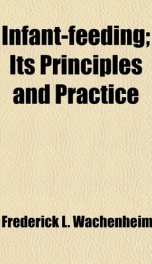infant feeding its principles and practice

Purchase of this book includes free trial access to www.million-books.com where you can read more than a million books for free. This is an OCR edition with typos. Excerpt from book: CHAPTER III. COW'S MILK. Practically the only available substitute for human milk is cow's milk. In some countries the milk of other animals has been given to infants, bu tin America the cow is the one prevailing source of supply. Cow's milk is a faintly acid fluid, of a yellowish- white color, that separates, on standing, into two layers. Within four to eight hours these layers are sharply defined, the upper very opaque, of a decided "creamy" yellow tint, containing nearly all the fat, and the lower translucent, bluish white, and nearly fat-free. The depth of the upper layer is more or less proportionate to the percentage of fat in the milk. Milk is sometimes turned blue by the Bacillus cya- nogenes (Hammer); this alteration appears to be harmless. Composition.The composition of milk obtained from Holstein or "grade" cows ranges about as follows: Water 87.0 to 88.0 per cent. Proteins 3.0 to 3.5 " Fats 3.5 to 4.0 Milk-sugar 4.5 " Salts 0.75 " The total caloric value of ordinary cow's milk ranges from 620 to 680 per liter (quart), or 19 to 21 per ounce, practically the same as of human milk. Clinicallythe inferior digestibility of cow's milk calls for a reduction from the above estimate of about 30 calories per liter, or 1 per ounce. Cows of the Guernsey or Jersey breeds give a far richer milk, with 4 per cent. of proteins, 5.5 or more of fats, and 5 of sugar, a caloric value of 850 or more to the quart, 25 or more to the ounce. It will be seen that the proteins are far more abundant than in human milk, the carbohydrates about as much less, and the fats about the same. The salts are nearly four times as abundant, and are divided about as follows (Pelka): Phosphoric acid 0.21 per cent. Lime ..... .0.15 " Potash . . Soda . . Chlorin Iron...
Info about the book
Author:
Series:
Unknown
ASIN:
B008KO8XUC
Rating:
4/5 (1)Your rating:
0/5
Languge:
English
Users who have this book
Users who want this book
What readers are saying
What do you think? Write your own comment on this book!
write a commentif you like infant feeding its principles and practice try:
Other books by this author
Do you want to read a book that interests you? It’s EASY!
Create an account and send a request for reading to other users on the Webpage of the book!

